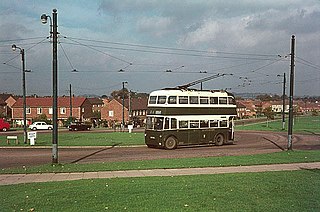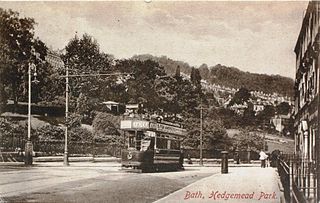Related Research Articles

In architecture, a clerestory is a high section of wall that contains windows above eye-level. Its purpose is to admit light, fresh air, or both.

London Buses route 7 is a Transport for London contracted bus route in London, England. Running between East Acton and Oxford Circus, it is operated by Metroline.

London Buses route 37 is a Transport for London contracted bus route in London, England. Running between Peckham and Putney Heath, it is operated by Go-Ahead London.

London Buses route 27 is a Transport for London contracted bus route in London, England. Running between Chalk Farm and Hammersmith Grove, it is operated by Transport UK London Bus.

Dundee Corporation Tramways formerly served the City of Dundee in Scotland. The corporation had financed the construction of a horse tramway in 1877, but had then leased it to the Dundee and District Tramways Company. They had replaced most of the horse trams with steam tram locomotives pulling trailer cars from 1884, but in 1897 the corporation decided that it would run the tramway system itself. After some negotiation and the payment of compensation, they took over the system in 1899, with a view to electrifying it. Electric trams started running in 1900, and the changeover was completed in 1902.

Belfast Corporation Tramways formerly served the city of Belfast, Northern Ireland.

The Rothesay tramway was a narrow gauge electric tramway on the Isle of Bute, Scotland. It opened in 1882 as a 4 ft gauge horse tramway, was converted to a 3 ft 6 in gauge electric tramway in 1902, and closed in 1936. It was the only public tramway to be built on a Scottish island.

The Derby trolleybus system once served Derby, the former county town of Derbyshire in central England. The trolleybus service started in 1932 and ran until 1967.
The Southend-on-Sea trolleybus system once served the town of Southend-on-Sea, in Essex, England. Opened on 16 October 1925, it gradually replaced Southend-on-Sea Corporation Tramways.

Cardiff Corporation Tramways was a company that operated an electric tramway service in Cardiff between 1902 and 1950.

Burnley Corporation Tramways operated a tramway service in Burnley between 1901 and 1935.

Cambridge Street Tramways operated a horse-drawn tramway service in Cambridge, England, between 1880 and 1914.

Tyneside Tramways and Tramroads Company operated an electric tramway service in Gosforth, Wallsend and North Shields between 1902 and 1930.
Aberdare Urban District Council Tramways operated a tramway service in Aberdare between 1913 and 1935. It was the only system in the United Kingdom which consisted of a tramway with feeder services run by trolleybuses from the start. The trolleybuses used the Austrian Cedes-Stoll system, and became increasingly difficult to maintain. Parts of the trolleybus network were converted to tramways in the early 1920s, and the rest stopped operating in 1925, when no trolleybuses were available for service. The tramway continued for another ten years, but was closed in 1934 and 1935 as a result of a downturn in the prosperity of Aberdare, due to collieries closing and the population dwindling. Motor buses took over the local services once the tramway had closed.
Airdrie and Coatbridge Tramways operated a tramway service in Airdrie and Coatbridge between 1904 and 1922 when it was taken over by Glasgow Corporation Tramways.

Bath Tramways Company and its successors operated a 4 ft horse-drawn tramway service in Bath between 1880 and 1902. From 1903 until its closure in 1939 an expanded route carried electric trams operated by Bath Electric Tramways Company.

West Ham Corporation Tramways operated a tramway service in the County Borough of West Ham between 1901 and 1933.
Rhondda Tramways Company operated a tramway service in Rhondda, Wales, between 1904 and 1934.
The Pontypridd and Rhondda Valley Tramway operated a tramway service in Pontypridd and Porth between 1888 and 1902.
The Provincial Tramways Company was a holding company for horse tramway companies in various regional towns of England. It was floated in July 1872 by means of a prospectus inviting public subscription for shares in the new company. The published prospectus lists the towns where it was proposed to operate horse tramways as Plymouth. Cardiff, Dundee. Portsmouth. Southampton and Tynemouth. Initially those in Plymouth and Cardiff were constructed and in operation as reported to the half yearly meeting of the company in 1873.